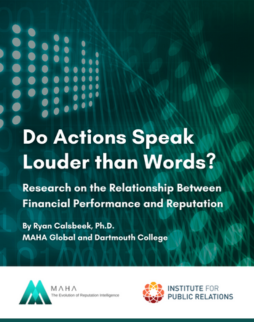This summary is presented by the IPR Behavioral Insights Research Center
Key Findings
- Salience nudges are designed to emphasize particular aspects of the decision-making process by drawing attention to them. However, they can backfire by only affecting certain groups and having unintended, negative consequences.
- A reminder of the opportunity costs of purchasing goods can lead thrifty people to become even more cautious about spending money, while not affecting the intended audience of people prone to overspending.
- A reminder of the benefits of spending money can have an unintended effect of focusing the attention of thrifty people towards the pain of spending money, further reducing their spending
Implications for Public Relations
Nudges can have unintended and negative consequences. Individuals with different characteristics respond to nudges differently, so it is essential to understand target audiences and test nudge interventions before implementation.
Nudges are an increasingly popular tool for public relations and communications. While nudges have been shown to be effective at changing people’s behaviour, research has begun to identify where they can have unintended and negative consequences. Practitioners need to be aware that nudges require rigorous testing through experiments like randomized controlled trials to ensure that they have the intended impact.
Although nudges operate on predictable cognitive biases and processes, individual differences can still have a substantial influence on how nudges are processed. Careful attention should be paid towards any differences within testing groups, not just between them. Practitioners may find that certain nudges may actually be inappropriate for some contexts or need to be more highly targeted to prevent potential harm.
Summary
Nudges are interventions that encourage a particular behaviour by guiding cognitive biases or mental shortcuts towards it. They have grown in popularity in recent years, but little research has been done to examine potential unintended consequences.
A central tenet for designing nudges is that they need to benefit the people being nudged. The idea of nudges emerged from research demonstrating that people don’t act rationally and often behave in ways that are counterproductive to their own attitudes or goals due to unconscious biases. By changing the outcome of these biases, nudges are able to reduce consistencies between attitudes and behaviour, and prevent the biases from having a negative impact.
However, nudges can end up hurting people instead of helping them, despite the best of intentions. Research by Thunström and colleagues examined how nudges designed to protect people from overspending can actually backfire, due to individual differences in how people feel about spending money.
A salience nudge is a nudge that draws attention to an aspect of the decision-making process so that it plays a more important role. A reminder about the opportunity cost of a purchase is an example of a salience nudge for reducing overspending. This study found that this salience nudge could actually be harmful to certain groups. The negative emotional reaction we have to spending money plays a big role in the decision-making process for making a purchase. Some people naturally feel less pain than others when spending money, resulting in overspending.
The researchers presented participants with a mock auction setting to examine their willingness to pay for goods. A salience nudge reminded some participants that the less they spend in the experiment, the more money they will have for other purchases. The results showed that the nudge reduced spending among those who were already predisposed to experience more emotional pain from spending. Those who feel less pain and are prone to overspend were not affected by the nudge, despite being the ones that would benefit from it. As a result, the nudge reduced overall consumer welfare.
A nudge in the other direction was also tested. It was designed to encourage spending among under spenders by highlighting the benefits, particularly support for local businesses. This nudge also only affected individuals who experienced more pain from spending, but reduced their spending, suggesting that the nudge ended up focusing attention on the pain of spending, instead of the benefits.
These findings demonstrate that nudges can interact with people’s emotions and information processing in unexpected and negative ways. Salience nudges designed to support consumer welfare when it comes to spending may actually exacerbate their tendencies instead. It is important to recognize that nudges affect people differently and need to be carefully evaluated, targeted, and revised in order to be successful.
Citation
Thunström, L., Gilbert, B., & Ritten, C. J. (2018). Nudges that hurt those already hurting–distributional and unintended effects of salience nudges. Journal of Economic Behavior & Organization, 153, 267-282. https://doi.org/10.1016/j.jebo.2018.07.005



